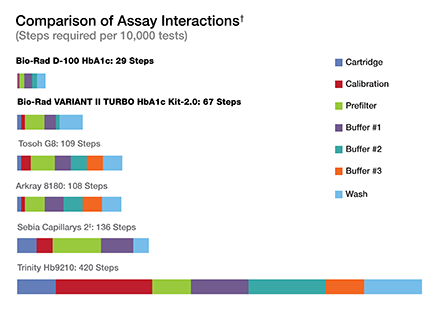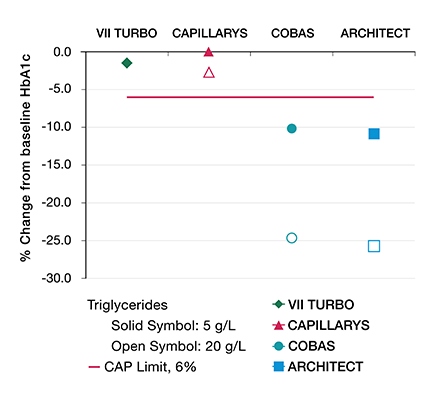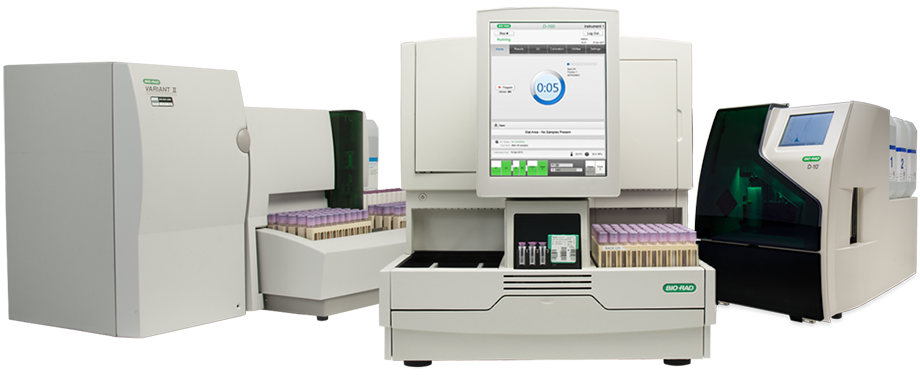Educational Resources
and References
Case Studies, Posters, and Performance Evaluations
-
Not all HbA1c Assays are Equal
Turn to Bio-Rad's HPLC for Quality Results

-
More doctors are turning to HPLC technology because separation of hemoglobins is critical for minimizing A1c interferences.
For over 40 years, Bio-Rad has been the leader in delivering HbA1c testing solutions. We believe in HPLC technology for helping you provide quality HbA1c results to healthcare providers and their patients.
Because missing one diagnosis is one too many.

-
More NGSP-Certified Labs1 Are Powered by Bio-Rad HPLC
The purpose of the NGSP is to standardize Hemoglobin A1c test results to those of the Diabetes Control and Complications Trial (DCCT) and United Kingdom Prospective Diabetes Study (UKPDS) which established the direct relationships between HbA1c levels and outcome risks in patients with diabetes.
- NGSP certification requires optimal instrument performance
- NGSP certification demonstrates DCCT and UKPDS traceability
- 40% of total NGSP Certified Labs* worldwide trust Bio-Rad HPLC for HbA1c
- 69% of total NGSP Certified Labs* worldwide trust HPLC for HbA1c
*Some labs have more than one certified instrument.
Reduce Redundant Operator Activities
-
Bio-Rad HPLC* requires the least operator interactions
Fewer...
- Reagent changes
- Calibrations
- Cartridge replacements
- Maintenance interactions
What would you do with more operator time?

*Study includes D-100 HbA1c and VARIANT II Turbo HbA1c Kit-2.0
†Interactions were evaluated by reviewing each of the assay's respective Instructions for Use (IFUs)
‡Includes capiclean every 500 tests
Why is Bio-Rad HPLC the Gold Standard for HbA1c?
-
In the presence of elevated HbF, Bio-Rad HPLC produces an A1c result you can trust.
In a case study comparing Bio-Rad HPLC VARIANT II TURBO to an immunoassay testing for HbA1c, the same patient sample resulted in different A1c diagnoses. How is this possible? What would you do with more operator time?

Does Lipemia Interfere with Your HbA1c Results?
In a study titled HbA1c platforms are variably affected by increasing lipemia, presented at AACC in 2018, the performance of nine routine HbA1c platforms was evaluated using clinically lipemic specimens. The study revealed that most immunoassays and the enzymatic method for HbA1c are susceptible to negative interference from elevated triglycerides while HPLC and CE methods are resistant. The data also suggests that a serum triglyceride threshold of ~10mmol/L may warrant a cautionary note when reporting HbA1c results.

-
Investigation of intralipid interference in HbA1c assays
Bio-Rad VARIANT II TURBO and Sebia CAPILLARYS reported HbA1c values without significant change from baseline in the presence of up to 20g/L intralipid-sourced triglycerides.
Roche COBAS® and Abbott ARCHITECT™ HbA1c values were negatively biased by approximately 10% and 25% at 5g/L and 20g/L triglycerides, respectively.

-
Investigation of clinical lipemia interference in HbA1c assays
Results A. Bio-Rad D-100, Sebia CAPILLARYS and Siemens Dimension Vista® HbA1c results did not show significant bias up to 65 mmol/L (57 g/L) triglycerides for 100%, 95% and 81% of specimens, respectively. Average bias was not significant for these three methods at any triglyceride threshold.
Results B. Beckman Coulter AU™ and Roche COBAS® HbA1c results showed significant bias above 10 mmol/L triglycerides (-12% for both), although these methods showed more random variation and/or a negative bias at low levels of triglycerides.
Results C. Ortho VITROS® and Abbott ARCHITECT™ HbA1c values were significantly depressed above a 10 mmol/L triglyceride threshold (-16% and -19% average bias, respectively), with bias increasing in proportion to the degree of lipemia.
An A1c Solution for Every Laboratory
Whether you're a small, medium, or large volume laboratory, our family of HbA1c testing solutions helps aid healthcare providers make the appropriate diagnosis and initiate the proper treatment protocol.
-
Learn More from the Experts
Bio-Rad's Hemoglobin Testing Webinar Series
To learn more about HbA1c and diabetes, register for our on-demand webinar.
Check out other Bio-Rad webinars that include topics on newborn screening and beta-thalassemia.
References
1. NGSP. (June 2019). List of NGSP Certified Laboratories. Retrieved from http://www.ngsp.org/docs/labs.pdf.
2. International Diabetes Federation (2017). IDF Diabetes Atlas, 8th edition. Accessed from http://www.diabetes.org.
3. Diabetes Care (2007). Consensus Statement on the Worldwide Standardization of the Hemoglobin A1c Measurement. 30(9), 2399-2400.

